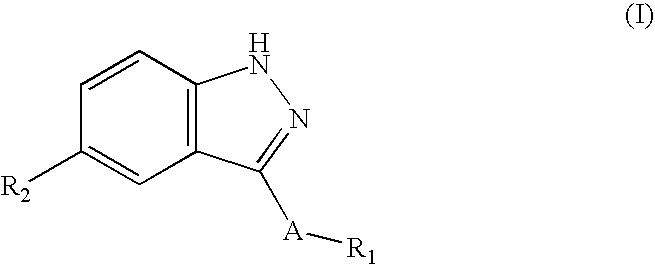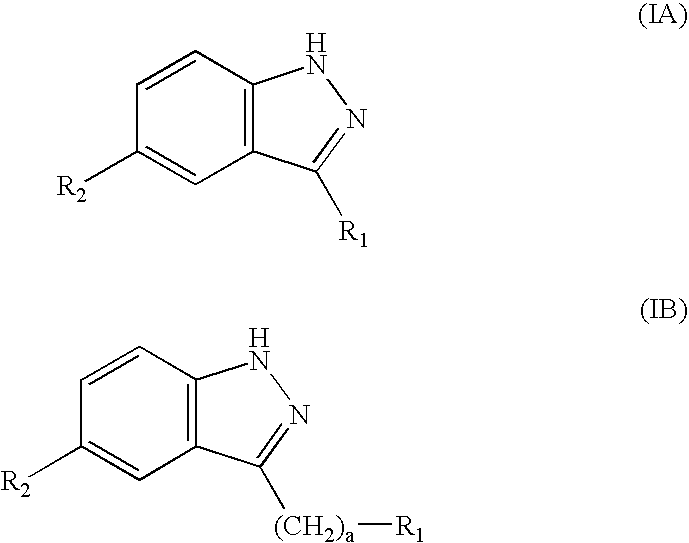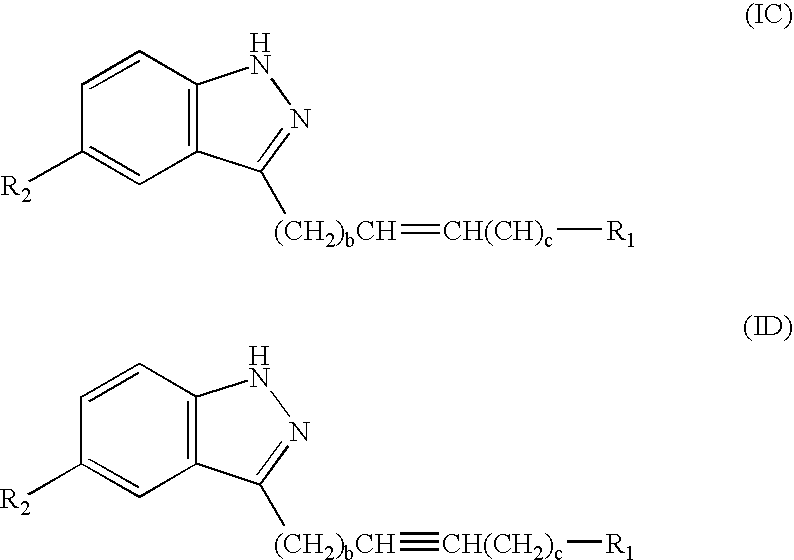0101] As used herein and unless otherwise indicated, the term "prodrug" means a JNK Inhibitor derivative that can hydrolyze, oxidize, or otherwise react under biological conditions (in vitro or in vivo) to provide an active compound, particularly a JNK Inhibitor. Examples of prodrugs include, but are not limited to, derivatives and metabolites of a JNK Inhibitor that include biohydrolyzable moieties such as biohydrolyzable amides, biohydrolyzable esters, biohydrolyzable carbamates, biohydrolyzable carbonates, biohydrolyzable ureides, and biohydrolyzable phosphate analogues. Preferably, prodrugs of compounds with carboxyl functional groups are the lower alkyl esters of the carboxylic acid. The carboxylate esters are conveniently formed by esterifying any of the carboxylic acid moieties present on the molecule. Prodrugs can typically be prepared using well-known methods, such as those described by Burger 's Medicinal Chemistry and Drug Discovery 6.sup.th ed. (Donald J. Abraham ed., 2001, Wiley) and Design and Application of Prodrugs (H. Bundgaard ed., 1985, Harwood Academic Publishers Gmfh).
0102] As used herein and unless otherwise indicated, the term "optically pure" or "stereomerically pure" means one stereoisomer of a compound is substantially free of other stereoisomers of that compound. For example, a stereomerically pure compound having one chiral center will be substantially free of the opposite enantiomer of the compound. A stereomerically pure a compound having two chiral centers will be substantially free of other diastereomers of the compound. A typical stereomerically pure compound comprises greater than about 80% by weight of one stereoisomer of the compound and less than about 20% by weight of other stereoisomers of the compound, more preferably greater than about 90% by weight of one stereoisomer of the compound and less than about 10% by weight of the other stereoisomers of the compound, even more preferably greater than about 95% by weight of one stereoisomer of the compound and less than about 5% by weight of the other stereoisomers of the compound, and most preferably greater than about 97% by weight of one stereoisomer of the compound and less than about 3% by weight of the other stereoisomers of the compound.
0103] As used herein, the terms "complex regional pain syndrome," "CRPS" and "CRPS and related syndromes" mean a chronic pain disorder characterized by one or more of the following: pain, whether spontaneous or evoked, including allodynia (painful response to a stimulus that is not usually painful) and hyperalgesia (exaggerated response to a stimulus that is usually only mildly painful); pain that is disproportionate to the inciting event (e.g., years of severe pain after an ankle sprain); regional pain that is not limited to a single peripheral nerve distribution; and autonomic dysregulation (e.g., edema, alteration in blood flow and hyperhidrosis) associated with trophic skin changes (hair and nail growth abnormalities and cutaneous ulceration). Unless otherwise indicated, the terms "complex regional pain syndrome" and "CRPS" include: type I, encompassing the condition known as reflex sympathetic dystrophy (RSD), which occurs after an initial noxious event other than a nerve injury; type II, encompassing the condition known as causalgia, which occurs after nerve injury; acute stage (usually hyperthermic phase of 2-3 months); dystrophic phase (showing vasomotor instability for several months); atrophic phase (usually cold extremity with atrophic changes); reflex neurovascular dystrophy; reflex dystrophy; sympathetic maintained pain syndrome; Sudeck atrophy of bone; algoneurodystrophy; shoulder hand syndrome; post-traumatic dystrophy; trigeminal neuralgia; post herpetic neuralgia; cancer related pain; phantom limb pain; fibromyalgia; chronic fatigue syndrome; radiculopathy; and other painful neuropathic conditions, e.g., diabetic neuropathy, luetic neuropathy, painful neuropathy induced iatrogenically by drugs such as vincristine, velcade or thalidomide.
0104] As used herein, unless otherwise specified, the term "treating pain" refers to the administration of a JNK Inhibitor, optionally in combination with another active agent or other therapy, after the onset of a symptom of pain, whereas "preventing pain"refers to the administration of a JNK Inhibitor, optionally in combination with another active agent or other therapy, prior to the onset of a symptom of pain, particularly to patients at risk of experiencing pain. Examples of patients at risk of experiencing pain include, but are not limited to, those who have incidents of trauma, neurologic disorder, genetic disorder, myocardial infarction, surgery, muscoskeletal disorder or malignancy. Patients with familial history of pain are also preferred candidates for preventive regimens. As used herein, unless otherwise indicated, the term "managing pain" encompasses preventing the recurrence of pain in a patient who has suffered from pain, and / or lengthening the time that a patient who has suffered from pain remains in remission. As used herein, unless otherwise specified, the term "modifying pain" means changing the way that a patient responds to pain. In one embodiment, "modifying pain" means bringing a patient's pain threshold from an elevated level (i.e., a level at which a patient experiences greater than normal pain in response to a particular stimulus) back to a normal level. In another embodiment, "modifying pain" means reducing a patient's pain response to a stimulus of a particular intensity. In another embodiment, modifying pain" means increasing a patient's pain threshold relative to the patient's pain threshold prior to the administration of an effective amount of a JNK Inhibitor.
 Login to View More
Login to View More 


